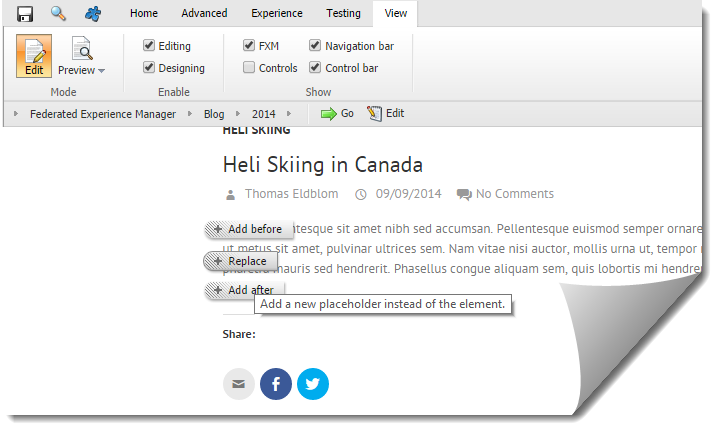The Customer Experience Management system landscape is incredible fragmented, covering amongst others content management, online customer service, e-commerce, campaign management, analytics and tracking, personalization, automation, social media, ad management, retargeting and many more, and most organisation have multiple systems in place – not only to handle different parts of the process, but often identical systems – like multiple CMS’s – to cover the same processes.
This scenario is not likely to change in the near future.
One of the newest features of the Sitecore Platform is the Federated Experience Manager, which can help connect a fragmented digital platform and make it possible to track and reach out to all visitors across all the owned channels in an organization.
Disconnected Platforms
Before joining Sitecore in 2014, I worked the last 14 years in a company called Pentia, based in Copenhagen, Denmark and since Pentia was the company from which Sitecore originally sprung in 2001, we were almost exclusively building Sitecore solutions for Danish and international customers.
Through the years, most of the clients I worked on aquired Sitecore as a major technological investment and as a new platform for driving their marketing efforts. So building or rebuilding their brand website, customer service website or e-commerce solution – and configuring the marketing tools – was almost always a major project for them.
When this is said, almost without exception, all would be stuck with one or more legacy websites or CMS systems following the migration or implementation project. This was not because the marketing division necessarily wanted it, but typically because the technical migration of their entire web platform would be too costly – or simply because Sitecore did not feel like the a good fit for a remaining systems.
So even though a lot of hours and smart people worked on implementing Sitecore and making the marketing platform better and giving the customers a better experience, it would often feel like we were working on a part that mattered very little.
Disconnected Experiences
We often saw that the legacy websites which were not converted to Sitecore was the e-commerce platforms, the direct customer service websites or the transaction websites. In other words, the websites actually giving the most value to the visitors – and often the organisation – and where the customer experience and visitor journey tracking was most vital to the success of the whole online platform, was being kept on legacy systems and technologies that were not allowing Sitecore to help marketing and customer service.
So the result was often a bad and very disconnected customer experience.
Seemingly simple things, like the visual design changing slightly from website to website, the overall flow or information architecture being bad or simply the content being wrong, not updated or just not assisting the customer towards the goal and the conversion. Furthermore the tracking and profiling capabilities of Sitecore was severely crippled, making the investment in personalization and optimization at best poor but often simply not worthwhile.
One platform, One Experience
Personally this was why I was rather excited when I first heard about the Federated Experience Manager a while ago.
By allowing Sitecore to reach out to non-Sitecore websites and applications and track visitor behaviour across these, we can start to see the entire visitor journey on the owned platforms and profile the users accordingly. But more importantly, we can start incorporating the legacy websites into the optimization effort, assisting the visitors on making those vital transactions, or start marketing our products or services on the websites where the visitor actually is, and not just where we would like them to be.
This will allow the marketing people to get even more control over all the digital channels – and ultimately make the investment in Sitecore and their new marketing platform much more valuable.
The Sitecore Federated Experience Manager
Sitecore Federated Experience Manager, FXM, will in short allow you to track the individual visitors across Sitecore and non-Sitecore websites using javascript tags – just like you know it from other analytics tools. This will allow you to use the standard Sitecore tools for goal tracking and visitor profiling. This mechanism is pretty much independent of technology, and FXM can even be used to track non-websites such as mobile apps.
But FXM will also allow you to push content from Sitecore to non-Sitecore websites and applications. This of course means that content can be maintained in one location within Sitecore and pushed across to other platforms. But potentially this can also be used to push theming and visual elements, to assure a unified user experience across all systems.
And since all content is managed and shared though the standard Sitecore mechanisms, we can leverage all Sitecores tools including personalization and A/B testing.
Finally FXM can be used to push data back to Sitecore too. This means that events and data from the external system can be sent across to Sitecore, and by leveraging Sitecores rules engine, we can trigger marketing events in Sitecore, for example engagement automation.
FXM is available for Sitecore 7.1 and forward on SDN.

 Over 15 years ago I spoke at the very first Sitecore conference at Trekroner, Copenhagen (yes, when and where the desktop background photo were taken) and today I did my very last session as a Sitecore employee at the SUGCON conference in Berlin.
Over 15 years ago I spoke at the very first Sitecore conference at Trekroner, Copenhagen (yes, when and where the desktop background photo were taken) and today I did my very last session as a Sitecore employee at the SUGCON conference in Berlin.

